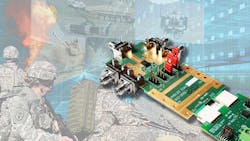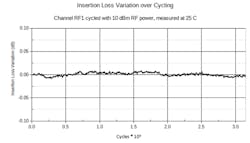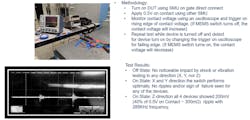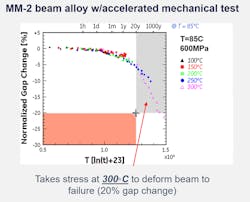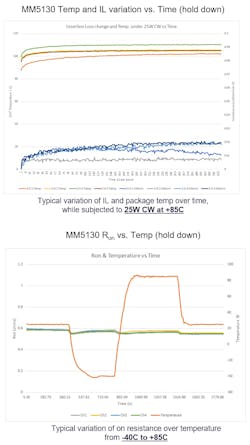RF MEMS Switches Take on Demanding Defense Applications
What you’ll learn:
- A new approach overcomes the inherent shortcomings of electromechanical relays and solid-state switches.
- What makes them reliable in harsh environmental conditions.
- How to withstand high peak voltages and RF power levels for years or even decades without failure.
Switches seldom receive the attention of more glamorous microelectronic devices like MPUs, GPUs, RF front ends (RFFEs), and other highly integrated technologies. However, without the ability to switch and route signals, no defense system could function.
If just a single switch among the hundreds or even thousands present in a system platform fails, the results could be catastrophic. Beyond loss of function alone, a switch failure could undermine the reliable operation of a mission-critical subsystem in a military platform designed for decades of unfailing service.
Whether operating on the ground, in the air, at sea, or in outer space, defense systems are designed to function flawlessly in extreme operating and environmental conditions. It should come as no surprise that military contractors invest considerable research and development effort in advanced components, materials, manufacturing processes, and software to ensure fail-safe operation of defense systems.
Even though traditional electromechanical relays (EMRs) are comparatively slow, large, heavy, power-hungry, and have short operating lives, EMRs remain a staple of everything from automated test systems to telecommunications equipment, and dozens if not hundreds of other applications. In extreme cases, they can consume tens of watts of power and must be replaced after just a few million switching operations.
However, mitigating the disadvantages of solid-state relays (SSRs) requires active thermal management in the form of fans, heat pipes, and large heatsinks, which are required in defense and other mission-critical applications to ensure that they will survive in extreme operating conditions. These components not only significantly increase system cost and complexity, but they also aren’t well-suited to small platforms such as UAVs, which must meet critical metrics such as power consumption, size, and weight.
What’s long been needed is an alternative that doesn’t suffer from the traditional limitations of EMRs while also providing better overall performance at a fraction of their size, along with minimal power consumption and much longer operating lifetimes. The answer comes in the form of microelectromechanical-system (MEMS) technology.
A New Approach to Switching
MEMS technology has been employed for decades in a wide variety of applications—e.g., microphones, automotive airbags, and an array of advanced sensing devices—but it’s relatively new for RF switching. A history of MEMS-based switch development over the past two decades is littered with more than a dozen companies that have tried and failed to solve the vexing challenges presented by this technology.
What was ultimately required was an entirely new approach to the challenge and extensive research and development of new metal alloys and other materials as well as advanced fabrication techniques. The result of these efforts comes at a time when systems are becoming smaller, more frugal with power, and packed with more features and functions previously performed by multiple discrete devices.
MEMS switches are based on breakthroughs in metal alloys that focus on minimizing metal fatigue. In fact, advances in alloys have effectively eliminated metal fatigue as a failure mechanism in the most advanced MEMS switches. The best of these devices can deliver stable performance after more than 3 billion on/off operations, a figure that soon will likely rise to more than 20 billion operations. Figure 1 shows highly stable insertion loss for more than 3 billion on/off cycles. In addition, some advanced switch designs can provide reliable operation when undergoing acceleration higher than 100 Gs.
For example, a single MEMS switch housed in a 2.5- × 2.5- × 0.9-mm chip-scale package can replace multiple electromechanical relays, and even huge matrices of MEMS switches consume less dc power than a single EMR. A MEMS switch not only switches 1,000X faster than an EMR, but it’s also at least 90% smaller, consumes tenths of milliwatts of power, and can survive more than three billion switching operations even when handling relatively high RF power levels.
A significant contributor to this high level of performance is the fact that while all switches employ a metal beam that actuates, MEMS switch actuators are so small their mass is negligible. This, in part, means they can deliver constant performance even during extreme shock and vibration, where most EMRs subjected to the same level of extreme vibration and shock testing would fail.
The closest competitor to MEMS switches is solid-state switches, which are smaller, faster, and more reliable than EMRs, but also are comparatively inefficient power consumers. To a lesser extent than their traditional electromechanical counterparts, solid-state switches generate considerable heat, which requires large, bulky heatsinks and complex thermal management. Moreover, semiconductors are never fully “off,” and the resulting leakage currents waste power.
In short, researchers throughout the world have been attempting for years to overcome the shortcomings of both traditional electromechanical and solid-state RF switches. However, the results have become a series of compromises rather than an ideal solution.
Breaking the Mold
The viability of MEMS switches in RF applications stems from research conducted by General Electric and spun out to create Menlo Micro. The company's Ideal Switch technology led to high-performance devices that could meet the demanding challenges of extreme operating environments without sacrificing performance.
Existing MEMS-based switches were unreliable under harsh environmental conditions, and Menlo Micro designed its own ohmic MEMS switch from scratch, going so far as to develop an advanced proprietary fabrication process using electrodeposited alloys. The result is an electrostatically actuated beam/contact structure that combines mechanical properties near those of silicon with the conductivity of a metal.
The Ideal Switch can handle more than 20 W of RF power, with no degradation in performance at high ambient temperatures, and with operating lifetimes measured in decades. Menlo Micro’s switches are fabricated using through-glass-via (TGV) packaging (using short, metallized vias), which dramatically reduces switch size, eliminating wire bonds for RF and microwave applications that also reduce package parasitics by more than 75%. This enables the Ideal Switch to operate from dc to 26 GHz, with forthcoming designs capable of pushing past 60 GHz in operating bandwidths.
Another benefit realized by Menlo Micro’s approach is the ability of MEMS switches to offer high thermal performance in harsh operating environments with minimal variation in RF performance over temperatures from −40 to +150°C. The company’s highest bandwidth switch, the MM5130, has operational performance data over this temperature range while achieving an insertion loss delta variation of 0.05 dB. Ideal Switch devices also have been used in extremely cold applications ranging from liquid nitrogen baths at −196°C to quantum-computing dilution fridges at temperatures below 10K.
Ideal Switch technology helps solve the problem of metal fatigue that’s plagued previous development efforts. The extremely low mass of these MEMS switch components also results in reliability levels far exceeding those of standard electromechanical switches, enabling superior environmental performance and resistance to shock and vibration. For example, the switch exceeds the IEC 60601/60068 standard and passes MIL-STD 810G/H stresses for vibration and shock.
Measurements Tell the Story
In its continuing development of Ideal Switch technology, Menlo Micro has performed hundreds of tests over several years to confirm its RF performance and environmental ruggedness. Three specific tests were conducted:
- IEC 60601/60068 standard: X, Y, and Z axis, 30 min.
- MIL-STD-810G random vibration: X, Y, and Z axis, 30 min.
- MIL-STD-810H random vibration: Z-axis.
Vibration testing in 6-dB increments above MIL-STD-810H were achieved, reaching the maximum level of the vibration table at 62 GRMS (root-mean-square acceleration).
One of these tests determined if the switch actuators would inadvertently open and close when exposed to extreme shock and vibration. The test setup monitored the switch during stress and analyzed the resulting data for any transient open or close operations. The results (Fig. 2) showed that there was no performance degradation during and after stress verification. These measurements exceed the requirements of IEC 60601/60068 standard and MIL-STD 810G/H stresses.
Another test was conducted to verify Menlo Micro switch performance during accelerated lifetime conditions for mechanical ruggedness (Fig. 3). A temperature of 300°C was required to deform the beam to failure, which shows that the Ideal Switch can deliver decades of operating life under these conditions.
Military aircraft and other defense platforms typically operate at both very low and very high altitudes, which creates rapid and extensive temperature cycling. To evaluate Ideal Switch devices when exposed to these conditions, they were subjected to on-resistance (hold-down) versus temperature over a range of −45 to +85°C. Figure 4 shows temperature cycling over a range of 0 to +100°C, and the results confirm that there’s virtually no resistance change over time.
Further tests of Ideal Switch technology went to the opposite extreme, with the goal of determining how the switch would perform under extraordinarily cold temperatures. The test setup was constructed to turn the switch on and off in a bath of liquid nitrogen at a temperature of −196°C (77K), and the switch performed normally without detectable performance degradation.
Summary
Engineers have endeavored for decades to overcome the inherent shortcomings of electromechanical relays and solid-state switches, but the results have been a series of compromises rather than a nearly ideal solution to the fundamental challenges posed by these legacy switching technologies. The history of RF MEMS switch development has also been a series of disappointments.
After investing enormous amounts of time and effort, many researchers concluded that even though MEMS technology had great promise for switching, it also posed enormous challenges. The key challenge was how to manufacture MEMS switches at scale and configure them to withstand high peak voltages and RF power levels for years or even decades without failure.
On that front, RF MEMS switches can withstand high voltages and power levels in extreme operating conditions for demanding RF applications. Such switches can be fabricated in a similar fashion to standard silicon CMOS, enabling them to be manufactured in high volumes and scaled in voltage, current, and RF power handling.
About the Author
Jonathan Leitner
Senior Product Marketing Engineer, Menlo Micro
Jonathan Leitner is senior product marketing engineer at Menlo Micro. He has broad-ranging applications engineering experience pertaining to IoT, RF/wireless, microwave, and millimeter-wave communications industries. Prior to joining Menlo Micro, Leitner was a technical account manager for Sierra Wireless.
He holds a Master of Science degree in electrical engineering from the Ming Hsieh Department of Electrical and Computer Engineering at the University of Southern California and a Bachelor of Science degree in electrical engineering from the College of Engineering & Computing Sciences at the New York Institute of Technology.
